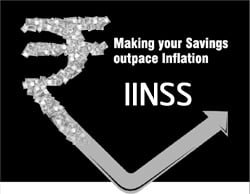
Inflation is eroding value of your money. Now do not let inflation erode the value of your money. Earn 1 .5 percent more than the inflation rate. Government of India has come up with new investment option called as Inflation Indexed National Savings Securities Cumulative (IINSS-C) bond scheme that will protect your savings from inflation and allow you to earn more interest on your savings.
Eligibility for Investment –
The Bonds may be held by
- Individual, not being a Non-Resident Indian-
- Hindu Undivided Family (HUF)
- Charitable Institution
Limit of Investment –
Minimum limit for investment in the bonds is 5,000 Rs/- and maximum limit for investment is 5 lakh Rs/- per applicant per annum.
Rate of Interest –
The Bonds will bear interest at the rate of 1.5% (fixed rate) per annum + inflation rate calculated with respect to final combined Consumer Price Index [(CPI) Base; 2010 = 100]. Final combined CPI will be used with a lag of three months to calculate incremental inflation rate (i.e. final combined CPI for September would be used as reference CPI for all days of December). Interest will be compounded with half-yearly rests and will be payable on maturity along with the principal.
There will be two parts in the interest rate. One, fixed rate of 1.5% per annum and second, inflation rate.
For example, if inflation rate during the six months is 5%, then interest rate for this six months would be 5.75% (i.e. fixed rate -0.75% and inflation rate -5%).
Tax Treatment –
Income Tax: Interest on the Bonds will be taxable under the Income-Tax Act, 1961 as applicable according to the relevant tax status of the bonds holder.
For example: If the inflation rate is 8% and the interest income is Rs 475 on Rs 5,000 (the face value), an investor falling in the 30% tax bracket would pay tax of Rs. 146.77 (30.90%). So, the net interest income becomes Rs.328.22. This amount is 6.56% of the invested amount; a rate below the inflation rate of 8%.
Should I Invest?
Before investing in Inflation Indexed National Saving Securities you must consider following facts –
- Looking at current inflation rate you will find this bond attractive but tax treatment of these bonds makes it unattractive compare to other investment option available in market.
- Remember inflation rate is always fluctuating and when the inflation rate comes down bond may lose its sheen. If inflation rate reduced to 6-7% than Inflation Indexed National Saving Securities end up giving you lower return compare to FD.
To get more idea checkout historic CPI inflation data given below (Reference – inflation.eu)
- Like other tax saving bonds you cannot trade these bonds in secondary market.
- Bond Tenor is 10 years Early repayment/redemption before the maturity date is allowed after one year of holding from date of issue for senior citizens i.e. 65 years and above of age, and for all others after 3 years of holding, subject to the penalty charges at the rate of 50% of the last coupon payable. Early redemption to be allowed only on coupon dates.
Factor mentioned above makes Inflation Indexed National Saving Securities not suitable for investment.
If you liked reading this post, do share with your friends on facebook and twitter!


